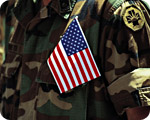Natural News
By David Gutierrez
July 26, 2010
 Use of prescription psychotropics has skyrocketed among U.S. military personnel in recent years, according to an investigation by Military Times.
Use of prescription psychotropics has skyrocketed among U.S. military personnel in recent years, according to an investigation by Military Times.
At least 17 percent of active-duty military personnel are currently taking an antidepressant, including as many as 6 percent of all deployed troops. In contrast, the rate of antidepressant use in the wider U.S. public is only 10 percent.
Overall, one in six military service members takes at least one type of psychiatric drug. The numbers are probably higher than estimated, since troops are also known to share and trade prescription drugs with each other, even while in combat zones.
Data obtained from the Defense Logistics Agency show that overall use of psychiatric drugs increased by 76 percent between 2001 and 2009. More specifically, use of anti-seizure drugs increased 70 percent, use of sedatives and anxiety drugs increased 170 percent, and antipsychotic use increased 200 percent.
Spending on anticonvulsants increased from $16 million to $35 million per year, spending on anxiety drugs and sedatives increased from $6 million to $17 million, and spending on antipsychotics increased from $4 million to $16 million.
Although antidepressants are among the drugs most commonly taken by military personnel, their use increased only 40 percent between 2001 and 2009. Spending actually dropped by 16 percent, likely reflecting the new availability of less-expensive generic drugs.
According to a 2009 study by the Veterans Affairs Administration, approximately 60 percent of psychiatric drug use by military personnel is for “off-label” uses not approved by the FDA. Thus, antipsychotic drugs intended for the treatment of schizophrenia are now being widely prescribed for post-traumatic stress disorder symptoms such as anger, headaches, nervousness and nightmares.
“Patients may be exposed to drugs that have problematic side effects without deriving any benefit,” said Robert Rosenheck of Yale University. “We just don’t know. There haven’t been very many studies.”
Further compounding concern over side effects, many troops regularly mix two or more drugs together into untested cocktails. The effects of multiple drugs acting in unison have rarely been tested. When both drugs act on the same organ — in this case, the brain — the chance of unforeseen interactions is even greater.
“In the case of poly-drug use — the ‘cocktail’ — where you are combining an antidepressant, an anticonvulsant, an antipsychotic, and maybe a stimulant to keep this guy awake — that has never been tested,” Breggin said.
Among the side effects that some health professionals worry about are impaired motor skills, reduced reaction time, increased suicide risk, irritability, aggressiveness and hostility.
“Imagine causing that in men and women who are heavily armed and under a great deal of stress,” psychiatrist Peter Breggin said.
Read entire article: http://www.naturalnews.com/029285_psychiatric_drugs_military.html


SHARE YOUR STORY/COMMENT